This post builds on Get Into Gears, Part 1 with ideas for classroom activities to explore gears and their properties, as well as some recommended books and other resources.
Classroom activities
1. Gear ratios
Create a series of gear trains with something to indicate "up" on each of the driver and the follower as in the following example.
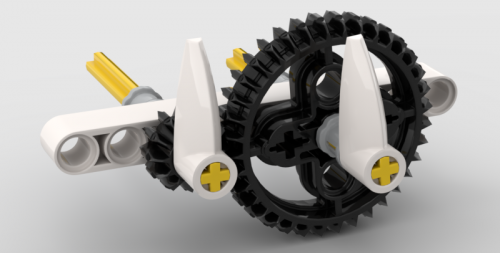
Divide the room in half. One side of the room watches the "input" (driver) and calls out each time it goes around ("one ... two ... three ...") while the other half watches the "output" (follower) and calls out each time it goes around ("one ... two ... three ..."). The idea is that they will end up calling out the gear ratio at the same time (e.g. for the 12:36 gear train, the input group will call out "3" when the output group calls out "1").

Include a gear train with a series of idler gears - same or different - to show that only the first and last gears matter in a simple (ie. non-compound) gear train. This is also a good time to have a conversation about how the direction the gears turn (clockwise or counterclockwise) switches with each gear interaction.
This approach to exploring gear ratios is developed further in the next activity.
2. Using gears to teach fractions
In Seymor Papert’s classic 1980 book Mindstorms (which the LEGO robotics range was named after), he talks about how he imagined fractions using gears when he was a child. Inspired by this, LEGO Engineering contributor Josep Fargas ran a practical workshop for 4th and 5th grade children using LEGO pieces to learn how fractions work.

The idea is to count how many turns the smaller gear does when the big one completes one turn and compare it with the number of teeth each gear has in the form of a fraction representation. After the students have built and counted several different constructions, they typically start giving the answers without building them.
For more about this idea, see the attached Gears and fractions PowerPoint presentation. (Look for the paperclip icon in the top-right corner of this post.)
This approach could be complemented with motors and color sensors to calculate turns with either rotations and/or using colors to calculate rotations. The machine could even ask you the result before it starts and test your answer!
3. Exploring SPIKE Prime gears
Using the double bevel gears found in the SPIKE Prime set, try building each of the gear trains described below. Sketch or list the gears you used for each.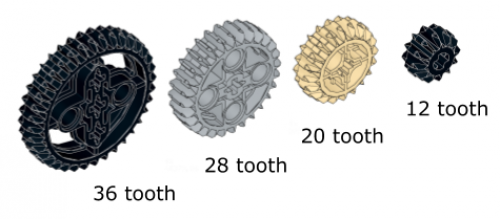
Look back at the gear trains you made. For each one, note whether it was gearing up, gearing down, or neither.
Remember that gearing up means that the follower in a particular gear train turns faster than the driver. Gearing down means that the follower turns more slowly than the driver.
Teacher Notes for Exploring Gears
Many combinations of the double-bevel gears can be meshed along a single beam. However, a few will not: the 36-tooth and the 20-tooth, for example, or the 28-tooth and the 12-tooth.
The SPIKE Prime set contains two of each type of gear—enough equipment to complete this challenge without using additional materials.
Sample solutions
4. Slow Animal Race
In this race, the slowest animal wins. The choice of slow animal is up to you—a snail, a turtle, a sloth, whatever you like—as long as it’s slow.
Here are the rules:
Once your animal is complete, document it:
Good luck and may the slowest animal win!
Teacher notes for Slow Animal Race
Stamp the Snake with student-designed 3D-printed gears
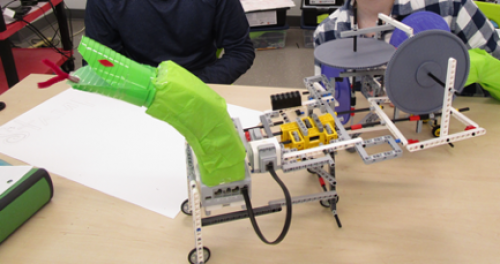
Flubby the Flounder
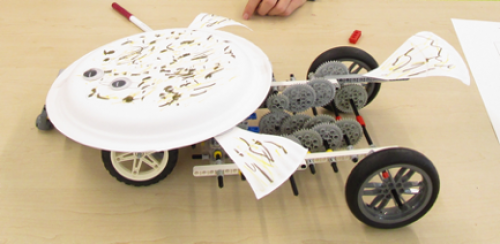
Schematic for Flubby the Flounder
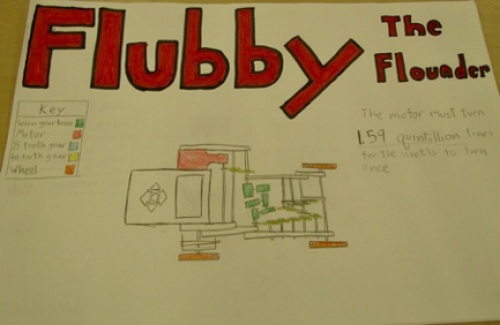
More classroom activities involving gears
For more challenges that focus on the use of gears, see these posts from the LEGO Engineering website. Books featuring LEGO gears
Every book by the amazing Yoshihito Isogawa is packed full of interesting and innovative uses of gears. His books feature a wide range of available LEGO gears used in all manner of incredible ways, such as the use of bevel gears to get motion in non-linear/non-perpendicular directions. All his books are essential resources for LEGO robot builders, but these are great place to start:
These websites are also definitely worth the time to check them out…
Finally, here’s an amazing gear train that has the potential to generate some interesting conversations in the classroom, including questions such as "What is a Googol?" as well as "Is the final gear really moving or not?"
This post features contributions from Josep Fargas (Using Gears to Teach Fractions), Ethan Danahy (Gear Ratios), and Barbara Bratzel (Exploring SPIKE Prime Gears, Slow Animal Race).
Classroom activities
1. Gear ratios
Create a series of gear trains with something to indicate "up" on each of the driver and the follower as in the following example.

Divide the room in half. One side of the room watches the "input" (driver) and calls out each time it goes around ("one ... two ... three ...") while the other half watches the "output" (follower) and calls out each time it goes around ("one ... two ... three ..."). The idea is that they will end up calling out the gear ratio at the same time (e.g. for the 12:36 gear train, the input group will call out "3" when the output group calls out "1").

Include a gear train with a series of idler gears - same or different - to show that only the first and last gears matter in a simple (ie. non-compound) gear train. This is also a good time to have a conversation about how the direction the gears turn (clockwise or counterclockwise) switches with each gear interaction.
This approach to exploring gear ratios is developed further in the next activity.
2. Using gears to teach fractions
In Seymor Papert’s classic 1980 book Mindstorms (which the LEGO robotics range was named after), he talks about how he imagined fractions using gears when he was a child. Inspired by this, LEGO Engineering contributor Josep Fargas ran a practical workshop for 4th and 5th grade children using LEGO pieces to learn how fractions work.

The idea is to count how many turns the smaller gear does when the big one completes one turn and compare it with the number of teeth each gear has in the form of a fraction representation. After the students have built and counted several different constructions, they typically start giving the answers without building them.
For more about this idea, see the attached Gears and fractions PowerPoint presentation. (Look for the paperclip icon in the top-right corner of this post.)
This approach could be complemented with motors and color sensors to calculate turns with either rotations and/or using colors to calculate rotations. The machine could even ask you the result before it starts and test your answer!
3. Exploring SPIKE Prime gears
Using the double bevel gears found in the SPIKE Prime set, try building each of the gear trains described below. Sketch or list the gears you used for each.
- The driver turns three times as fast as the follower in opposite directions.
- The follower turns three times as fast as the driver in opposite directions.
- The follower turns 5/3 times as fast as the driver.
- The driver and the follower turn at the same speed in the same direction.
- The follower turns nine times as fast as the driver. (There’s a trick to this one!)

Look back at the gear trains you made. For each one, note whether it was gearing up, gearing down, or neither.
Remember that gearing up means that the follower in a particular gear train turns faster than the driver. Gearing down means that the follower turns more slowly than the driver.
Teacher Notes for Exploring Gears
Many combinations of the double-bevel gears can be meshed along a single beam. However, a few will not: the 36-tooth and the 20-tooth, for example, or the 28-tooth and the 12-tooth.
The SPIKE Prime set contains two of each type of gear—enough equipment to complete this challenge without using additional materials.
Sample solutions
- Any gear train where the follower is three times as large as the driver will make the driver turn three times as fast as the follower. For example, a twelve-tooth gear meshed with a thirty-six-tooth gear. (Gearing down)
- Any gear train where the driver is three times as large as the follower will make the follower turn three times as fast as the driver. For example, a thirty-six-tooth gear meshed with a twelve-tooth gear. (Gearing up)
- Any gear train where the driver is five/thirds times as large as the follower will make the follower turn five/thirds times as fast as the driver. For example, a twenty-tooth gear meshed with a twelve-tooth gear. Since the directions of turning are not specified, the driver and the follower may be meshed with each other or separated by a follower. (Gearing up)
- Any two gears of the same size, with an idler between them, will turn at the same speed and in the same direction. For example, two thirty-six-tooth gears with a twelve-tooth gear between them. (Neither gearing up nor gearing down)
- A gear train with stacked gears on a single shaft will allow the follower to turn nine times as fast as the driver. The first axle holds a thirty-six-tooth gear. The second axle contains two gears, a twelve-tooth gear meshed with the large gear on the first axle and a thirty-six-tooth gear. The thirty-six-tooth gear on the second axle is meshed with a twelve-tooth gear on the third axle. Each pair of gears increase the speed by three times, so the two pairs together give an increase of three times. (Gearing up)
4. Slow Animal Race
In this race, the slowest animal wins. The choice of slow animal is up to you—a snail, a turtle, a sloth, whatever you like—as long as it’s slow.
Here are the rules:
- Your animal must include a LEGO MINDSTORMS or SPIKE Prime hub, one or two motors, and one or more gear trains. You may 3D print custom gears in addition to using LEGO gears. You may also use craft materials, such as pipe cleaners and tissue paper, for decoration.
- Your animal must move forward at a constant pace during the race, though its forward motion can be very slow. In other words, no stopping, no turning, and no backing up.
- Your animal must be recognizable to a bystander as whatever animal it is.
Once your animal is complete, document it:
- Calculate the slowdown—how many times your motor must turn in order for your wheels to turn once.
- Make a careful schematic of your gear train, showing how the gears mesh with one another. Your drawing does not need to be realistic; you may use symbols to represent the various sizes of gears. Be sure to include a key.
Good luck and may the slowest animal win!
Teacher notes for Slow Animal Race
- Before doing this activity, be sure that the students are familiar with gear trains, including compound gears.
- If you have access to worm gears, they make a good addition to this activity.
- If you do not have access to a large supply of gears, you may want to set limits on how many gears each group may use.
- Though this activity is billed as a race, try to de-emphasize the competitive aspects. In reality, many of the animals will be so slow that it will be nearly impossible to determine a winner.
- You may want to add an additional constraint that the students must demonstrate that their animal moves forward, at least in theory, rather than moving backward (a real possibility, given the complexity of the gear trains).
Stamp the Snake with student-designed 3D-printed gears

Flubby the Flounder

Schematic for Flubby the Flounder

More classroom activities involving gears
For more challenges that focus on the use of gears, see these posts from the LEGO Engineering website. Books featuring LEGO gears
Every book by the amazing Yoshihito Isogawa is packed full of interesting and innovative uses of gears. His books feature a wide range of available LEGO gears used in all manner of incredible ways, such as the use of bevel gears to get motion in non-linear/non-perpendicular directions. All his books are essential resources for LEGO robot builders, but these are great place to start:
- The LEGO Technic Idea Book Set (3 books), Yoshihito Isogawa (2011)
- The LEGO MINDSTORMS EV3 Idea Book, Yoshihito Isogawa (2014)
- Unofficial LEGO Technic Builders Guide, 2nd Edition, Pawel “Sariel” Kmieć (2016) - Includes a comprehensive inventory of LEGO gears and terminology associated with their use.
- THE LEGO MINDSTORMS EV3 Discovery Book, Laurens Valk (2014) - This definitive text on the EV3 has an excellent section on gears, and includes plenty of great ideas for activities that could be adapted for the classroom. Although the focus is obviously on the gears in the EV3 set, there's plenty that applies to other platforms.
These websites are also definitely worth the time to check them out…
- Gear Generator (https://geargenerator.com/) - This a tool for creating spur gears and simulating how they interact with each other. Although not directly applicable to LEGO gears, it's very pretty and lots of fun!
- LEGO™ Gear Ratio Calculator (http://gears.sariel.pl/) - In addition to a tool for determining the gear ratios of simple and compound gear trains, this site allows has a tool that helps you to find combinations of gears for given driver and follower axle positions. Very handy!
- Bricklink - Wondering where to get hold of a particular LEGO gear? Bricklink is like the ebay of LEGO and features an extensive catalog of every LEGO element and set that has been released.
Finally, here’s an amazing gear train that has the potential to generate some interesting conversations in the classroom, including questions such as "What is a Googol?" as well as "Is the final gear really moving or not?"
This post features contributions from Josep Fargas (Using Gears to Teach Fractions), Ethan Danahy (Gear Ratios), and Barbara Bratzel (Exploring SPIKE Prime Gears, Slow Animal Race).
Blog Think Like An Engineer
11/16/2020 5:00pm EST
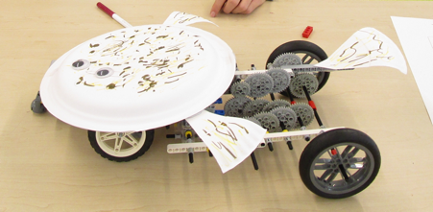
Leave a Comment